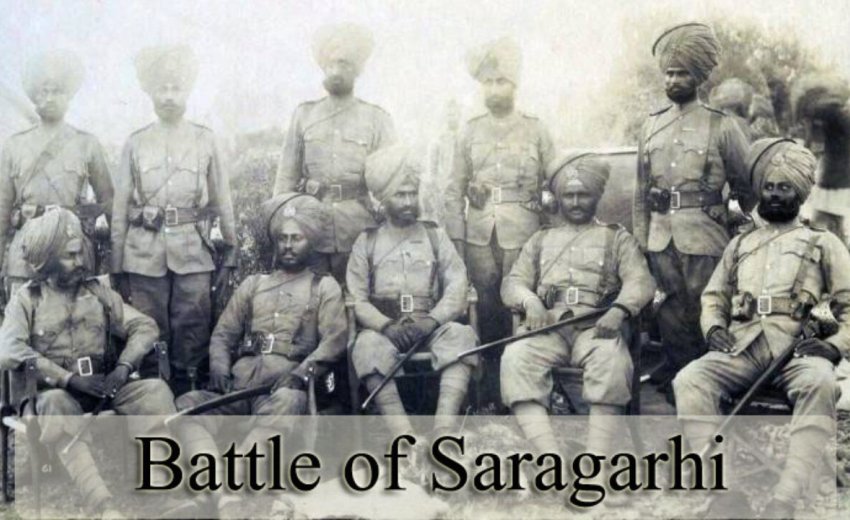On September 12, 1897, a historic battle known as the Battle of Saragarhi took place in the North-West Frontier Province, now part of Pakistan. Twenty-one Sikhs from the 4th Battalion (then 36th Sikhs) of the Sikh Regiment of British India valiantly defended an army post against a massive force of 15 to 20 thousand Afghan and Orakzai tribesmen during the Tirah Campaign.
Led by Havildar Ishar Singh, the Sikhs displayed extraordinary courage and chose to fight to death . This significant event is commemorated annually on 12th September by both Sikh military personnel and civilians, observed as Saragarhi Day to honor the bravery and sacrifice of those who fought in the battle.
The tale of valour
Saragarhi, a quaint village on the Samana Range in Kohat, Pakistan, holds historical significance. Back in August 1897, Lt. Col. John Haughton led five companies of the 36th Sikhs to the North West Frontier Province, stationed at various forts, including Samana Hills, Kurag, Sangar, Sahtop Dhar, and Saragarhi.
The region faced periodic attacks by Pashtuns, leading to the consolidation of forts, such as Fort Lockhart and Fort Gulistan. As these forts were not visible to each other, Saragarhi emerged as a vital communication post situated on a rocky ridge. It comprised a small blockhouse with loop-holed ramparts and a signaling tower.
In 1897, a general Afghan uprising took place, and from August 27 to September 11, the 36th Sikh regiment bravely repelled numerous attempts by Pashtuns to capture the forts, showcasing resilience and valour in the face of adversity.
The attack
On September 12, 1897, a big group of Pashtuns, about 15,000 to 20,000 of them, attacked the signaling post at Saragarhi. Their goal was to cut off communication between two forts. Around 9:00 am, the Afghans reached the signaling post.
Gurmukh Singh quickly signaled to Colonel Haughton in Fort Lockhart, letting him know they were under attack. Unfortunately, Colonel Haughton couldn't send help to Saragarhi. Even though they were outnumbered, the soldiers at Saragarhi decided to fight until the end. They were determined to stop the enemy from reaching the forts.
Bhagwan Singh got hurt first, and Lal Singh was badly injured. Soldiers Lal Singh and Jiwa Singh bravely carried Bhagwan Singh's lifeless body to the inner part of the post. The enemy managed to break a part of the picket's wall, and a fierce battle unfolded.
Colonel Haughton signaled that around 15,000 to 20,000 Pashtuns were attacking Saraghari. The Afghan leaders tried to make promises to convince the soldiers to surrender. There were two strong attempts to rush through the open gate, but both failed.
In a very brave move, Ishar Singh told his soldiers to retreat to the inner layer while he stayed behind to fight. Unfortunately, the inner layer also broke, and almost all the defending soldiers, as well as many Pashtuns, lost their lives.
The final Sikh defender, Signalman Gurmukh Singh, who was in touch with Col. Haughton, throughout the battle, sends his last message to Haughton, saying, “This is my last signal. Picking up gun to fight.” He reportedly killed more than 20 Afghans. While on his deathbed, he was heard shouting "Jo Bole So Nihal, Sat Sri Akal" repeatedly, according to information from Afghan sources.
The Afghans later claimed that around 180 were killed and many more were injured during the battle against the 21 Sikh soldiers. However, when the relief party arrived, they reported seeing about 800 bodies around the destroyed post. All 21 Sikhs were posthumously awarded the Indian Order of Merit, the highest gallantry award at that time for Indian soldiers conferred by the British crown. The names of the 21 recipients of the gallantry award are:
Havildar Ishar Singh (regimental number 165), Naik Lal Singh (332) Lance Naik Chanda Singh (546), Sepoy Sundar Singh (1321), Sepoy Ram Singh (287), Sepoy Uttar Singh (492), Sepoy Sahib Singh (182), Sepoy Hira Singh (359), Sepoy Daya Singh (687), Sepoy Jivan Singh (760), Sepoy Bhola Singh (791), Sepoy Narayan Singh (834) Sepoy Gurmukh Singh (814), Sepoy Jivan Singh (871) Sepoy Gurmukh Singh (1733), Sepoy Ram Singh (163), Sepoy Bhagwan Singh (1257), Sepoy Bhagwan Singh (1265), Sepoy Buta Singh (1556), Sepoy Jivan Singh (1651), Sepoy Nand Singh (1221).
The remarkable stand of the small group of Sikh soldiers against a thousand tribal attackers in the Battle of Saragarhi has been compared to the historic Battle of Thermopylae, where 300 Spartans held their ground against a massive Persian army in 480 BC.
Notably, during the Battle of Saragarhi, the British could not send help until after the 21 Sikh soldiers had fought valiantly to their last breaths, much like the Spartans at Thermopylae who also stayed and fought after their lines were breached. Despite the incredible bravery shown by these Sikh soldiers, their story is often forgotten today. Sadly, little is known about their descendants, which is a disgrace. However, tracing their lineage should be possible, as only 113 years have passed since the event. Perhaps in a home in Punjab, there's a Sikh family proudly displaying a photo of their Great-Great Grandfather Havaldar Ishar Singh, one of the heroes of Saragarhi.
The Sikh community has not forgotten the sacrifice of these brave soldiers. Commemorative gurdwaras were built in Amritsar, Ferozpur, and at Saragarhi. Every year on September 12, services are held at these sites to honor and remember the courage of those who stood strong in the face of overwhelming odds.
Each year, the Sikh Regiment holds a special event called Saragarhi Day to honor brave soldiers who sacrificed their lives. This memorial Akand Paath serves as a heartfelt remembrance for the twenty-one heroes who gave their all at an isolated outpost 113 years ago. The Indian Army pays a respectful tribute to these fallen soldiers, acknowledging their supreme sacrifice on this significant day.
*Based on an article by JS Bedi, published in India Post News Service on 13th September 2011
